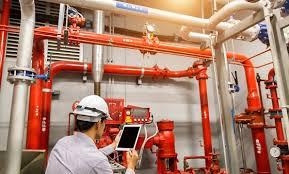With the age of rapid e-commerce, global supply chains, and rising warehouse rents, high-pile storage has become a default solution for maximizing vertical space in commercial and industrial buildings. However, very few warehouse managers and facility operators realize that storing merchandise at great heights comes with extreme fire safety and compliance risks—risks that can cost facilities pricey citations, shutdowns, and even life-changing events.
As a high pile storage consultant, we recognize far too many warehouses that don't even know that they are violating local fire codes or under-preparing for inspections, just because they don't actually understand what constitutes a "high pile" or what the resulting standards are.
Here, Compliance First will examine the dangers of high pile storage, the regulations around it, and how compliance can be met without affecting storage space or efficiency.
What Is High Pile Storage
High pile storage is the storage of flammable materials in densely piled stacks or on racks over a specified height—ordinarily 12 feet or more (and, in some cases, less for very flammable materials). High-pile storage can be composed of boxes, pallets, paper rolls, plastics, or fabrics.
High pile storage is controlled primarily due to the increased fire load and complexity of extinguishing of fires in tight, stacked-up piles. In most regulations, storing combustibles above established amounts triggers added code provisions, including:
- Fire protective equipment (sprinklers, smoke vents)
- Fire department access
- Commodity classification
- Aisle spacing
- Inspections and permits
- The Hidden Hazards You Might Not Be Seeing
- Unidentified Fire Load Risk
The most prevalent and risky threat is that of underestimating the fire load of your building. Having high pile storage increases the quantity of combustible material per square foot, particularly in the case of storing plastic, foam, or other high-hazard commodities. All such materials burn quicker and produce more heat and smoke, overloading traditional fire suppression systems.
Consultant's Tip: Proper commodity classification and fire load analysis should be included in your pre-implement/expand high pile storage risk assessment.
- Non-Compliant Layouts
Higher stacks are often equivalent to narrower aisles and more elevated racks—both of which, if inadequately designed, contravene fire code regulations. Some of the concerns are:
- Too narrow access for the fire department
- Blocked sprinkler heads or fire exits
- Flue spacing errors (the open spaces among pallets)
- Inadequately marked storage areas
Any of these violations can result in failed inspections or a denied high pile storage permit.
- Inactive or Ineffective Fire Protection Systems
Not every fire suppression system is up to the task of high pile configurations. For instance, standard sprinklers do not go far enough into a high stack, especially in denser storage conditions. Ineffective systems translate to late detection of fires, ineffective suppression, and catastrophic loss.
Some applications may require:
- Early Suppression Fast Response (ESFR) sprinkler systems
- Smoke and heat venting
- Firewalls or separation zones
- Smoke detection at different vertical points
A storage consultant who specializes in high-pile storage can assess whether your current system is compatible with your storage configuration and what upgrades may be needed.
- Missing or Inaccurate Permits
High pile storage over a specific height (usually 12 feet) in most jurisdictions does require a special fire department permit. This usually includes:
- Providing a detailed floor plan and storage layout
- Advertising material designations
- Displaying fire protection aspects
- Scheduling and conducting a fire inspection
Not obtaining the proper permits may result in fines, shutdowns, or insurance claim denial if there is a fire.
- No Emergency Planning and Staff Training
If your warehouse layout changes frequently, or if staff aren't aware of regulations for high pile storage, emergency preparedness suffers. It isn't enough to have written fire extinguishers and exit paths to work. Staff needs to be trained to:
- Where and how to find and turn on extinguishers
- How to notify someone of malfunctioning sprinkler heads or storage positioning
- When a new configuration might require new compliance practices
- How to Stay Compliant: Best Practices
Staying compliant with the rules of high pile storage requires being proactive and
well-documented. Here's how to stay one step ahead:
- Employ a High Pile Storage Specialist
A certified high-pile storage consultant will:
- Categorize your commodities properly
- Inspect your fire protection systems
- Create compliant storage plans
- Help prepare permit applications
- Work directly with local fire departments and code officials
- Keep Documentation Up to Date
Maintain a neat, easily accessible file of:
- Permits and inspection reports
- Floor plans and storage schematics
- Fire system specifications
- Staff training logs
Final Thoughts
A high pile storage consultant offers tremendous advantages with regard to space optimization, but the fire safety risks are equally significant. Worthwhile consultants in this field have seen that often, these good companies fall into the pitfall of non-compliance or expose themselves to the hazards of fire simply because one crucial detail may have been overlooked.
Compliance first says whether building a new warehouse, retrofitting an existing one, or getting ready for an inspection, having a high-pile storage consultant at your side is one of the best things you can do about protecting your business, employees, and bottom line.
